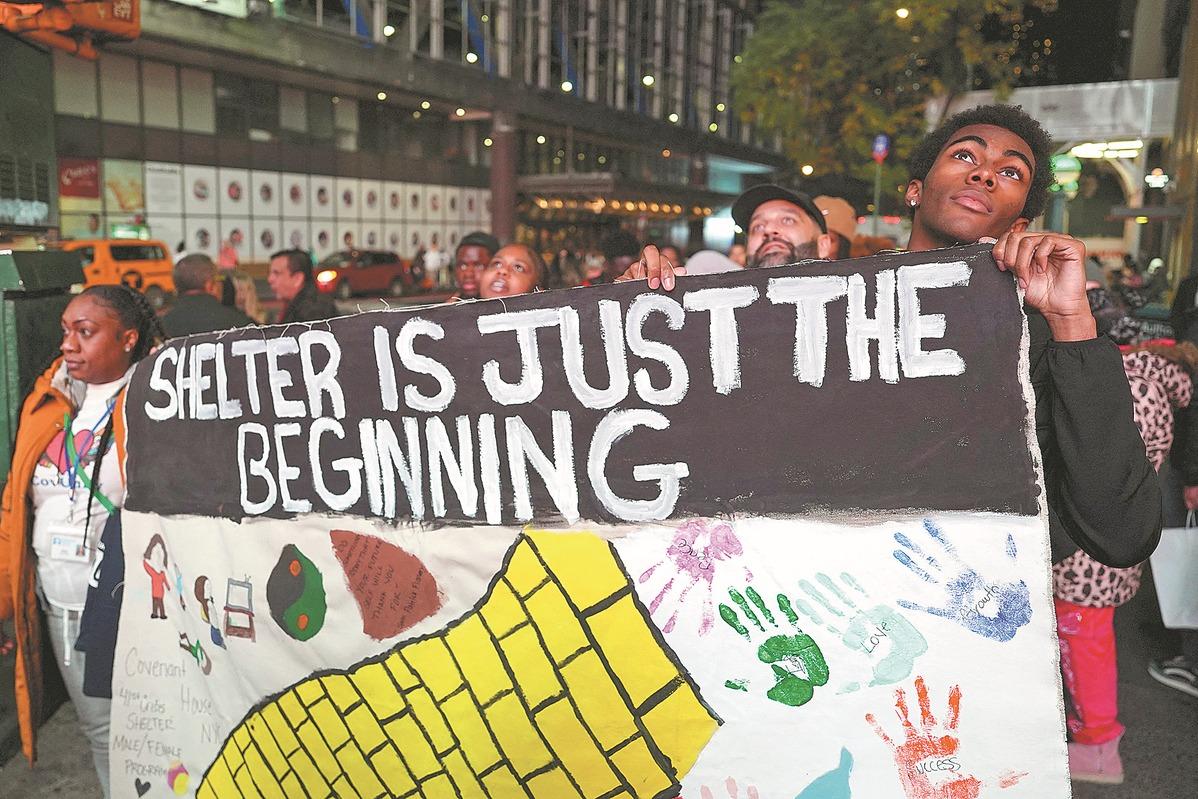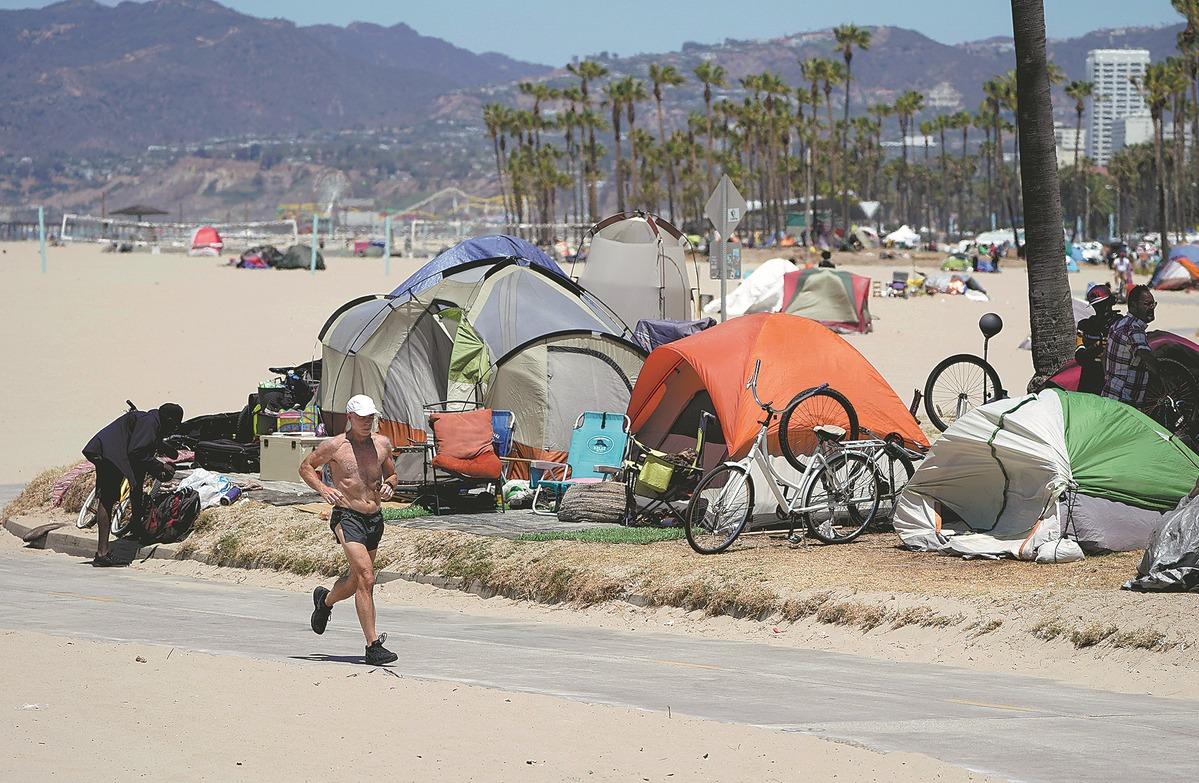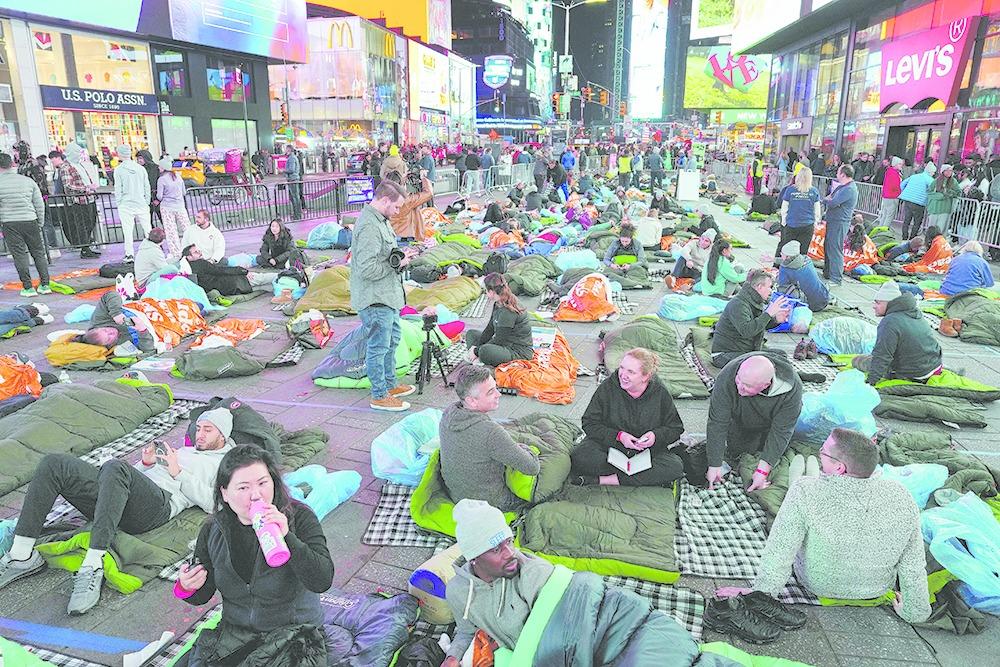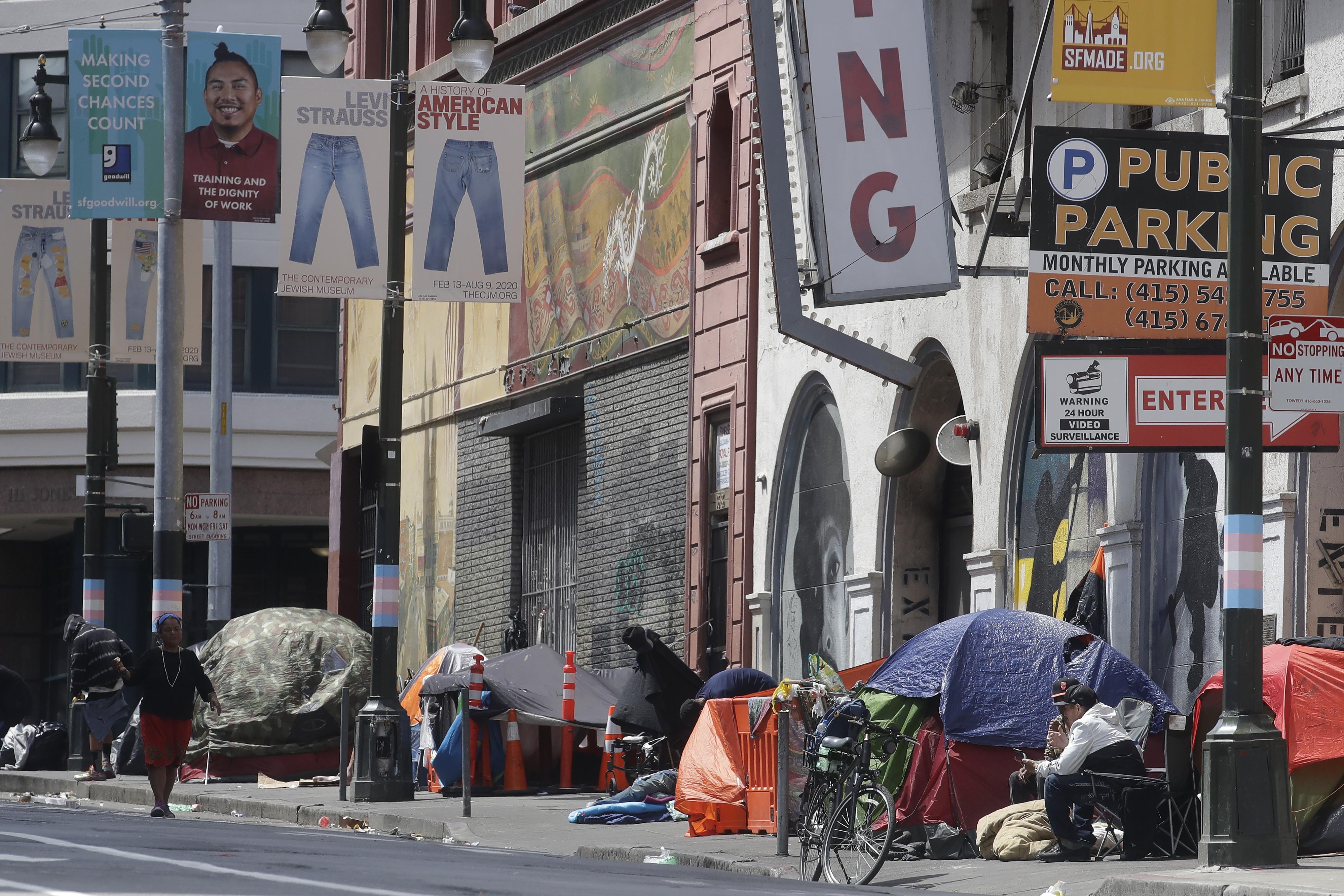Editor's note: As the number of people living in motor vehicles changes the nature of homelessness in the United States, China Daily looks at their struggles, hopes and resilience.
 People march to Times Square, where they planned to voluntarily sleep the night, to highlight homelessness in New York on Nov 16, 2023. (PHOTO / REUTERS)
People march to Times Square, where they planned to voluntarily sleep the night, to highlight homelessness in New York on Nov 16, 2023. (PHOTO / REUTERS)
Rising housing costs, inflation, limited shelter availability are driving a new and complex form of homelessness
Hiding in plain sight amid the hustle and bustle of everyday life are a growing number of US people who temporarily and sometimes permanently live in their cars, vans and recreational vehicles in large cities and small towns across the country.
The mobile homeless, as they are dubbed, live in cramped conditions, often have breakfast in the front seat of their vehicle, wash and do their hair in public toilets, put on their clothes, paint on a smile and sometimes go to work.
It is estimated that more than 500,000 people in the United States were homeless on any single night last year and had nowhere to live. Of those, 40 percent lived on the street or in their cars, said the Annual Homeless Assessment Report published by the US Department of Housing and Urban Development.
Many have not told their family, friends or co-workers of their plight, said case workers who deal with them daily. They often go quietly about their day, despite having no apartment or house to call home.
READ MORE: Deep-rooted poverty engulfs 37m in US
In a move aimed at helping this group, "safe parking lots" have sprung up in many places, including Duluth, Minnesota; several counties in California; Green Bay, Wisconsin; King County, Washington; and Denver, Colorado. They allow people to leave their car in a locked, monitored parking area so they can stay in it overnight. They must leave at 7 am the next day.
One woman aged 59 who did not want to be identified said she ended up in the Colorado Safe Parking Initiative after a divorce depleted her savings and she had a long stay in a hospital.
Unable to keep up with her rent, she lost the room she lived in after the owner sold the house. She scrambled to find another place but could not, she said.
So she put her belongings into storage and climbed into the one possession she had left, her car. However, there was more bad news: she had breast cancer.
 A jogger runs past a homeless encampment in the Venice Beach section of Los Angeles on June 8, 2021. (PHOTO / AP)
A jogger runs past a homeless encampment in the Venice Beach section of Los Angeles on June 8, 2021. (PHOTO / AP)
To make ends meet the master's degree graduate became an Uber driver. Every morning she would gather her things from the car and put them into the storage unit, go to work and engage in chitchat with her passengers.
However, at night she would shower at a gym, she said, go to her storage locker to get her belongings back out and feel stressed out about how to keep her new life a secret from family and friends. She felt "ashamed and embarrassed", she said.
"I'm such a successful person, and here I am ending up homeless," she said in a testimonial for the US nonprofit group Safe Lot. "Having to keep a secret like that was very stressful."
She told of how others in the Safe Lot rallied to help her as she underwent radiation therapy because we "all looked after each other".
ALSO READ: Homelessness rates soaring in US states
Life eventually got better when she secured a permanent apartment. She credits Safe Lot as the main reason she got "a chance to breathe".
Safe Lot, established in 2020, says it helps nearly 120 households a night. This includes individuals, couples and families in 13 Safe Lots across metropolitan Denver. Its funding comes from government contracts and foundation grants and a variety of other sources.
Terrell Curtis, executive director of the Colorado Safe Parking Initiative, said: "In Colorado, like most places, sleeping in a car isn't legal, so for those people who do, they are harassed at night or become victims of crime.
"And since it's illegal they are made to move along by police frequently. It is very difficult to get rest; 40 percent of the people we serve are working and need good sleep to keep their jobs as well as maintain reasonable health. The Colorado Safe Parking Initiative also offers case management services to support people in regaining stable housing, employment and healthcare."
In June Denver's city council approved $600,000 to create two new Safe Lots that the initiative will run.
Derek Woodbury, communications director for Denver's Department of Housing Stability, was instrumental in pushing for an update in the city's contract with the initiative and a budget increase.
 A pedestrian takes cover under a blanket on Nov 9, 2023, in Anchorage, Alaska, as plows clear the roadway. (PHOTO / AP)
A pedestrian takes cover under a blanket on Nov 9, 2023, in Anchorage, Alaska, as plows clear the roadway. (PHOTO / AP)
"Denver's very much a caring city and working hard to make progress in homelessness resolution," Woodbury said.
"We're doing all that we can to ensure that episodes of homelessness are experienced rarely, and where they are they're brief, one-time occurrences. We invest in shelter alternatives, and safe parking is an example."
Woodbury said Denver had been invested from President Joe Biden's American Rescue Plan Act of 2021. Of 30 percent of people who stay at a Safe Lot in the City and County of Denver, one-third go on to live in permanent housing, he said.
The essential, free parking spaces, hosted by churches, if zoning laws allow, or in existing parking lots, also provide people with a much-needed warm shower, dinner from donated food and, importantly, someone to talk to. In extremely bad weather some offer a night in a motel.
ALSO READ: US cities remain clueless as thousands go homeless
Jesus Garcia, program coordinator for CAREavan, a safe parking program in Union City, Alameda County, California, has seen the look of relief in the eyes of individuals and families who arrive after living in a cramped car.
" (For these families) just having basic necessities, as far as restrooms and having a safe place to sleep at night (is vital).
"So, they can do what they need to do with the time without worrying about it at night by really having a safe place to sleep where they can rest, relax. This way they can attend their meetings and do what they need to be able to do to get out of a situation they are in.
"We realized ... some families (who) were attending some of our other programs... were sleeping in a vehicle and ... in an unsafe parking lot. And we just wanted a place for them to start sleeping. So that's why we started the program back in 2016."
 People march to Times Square, where they planned to voluntarily sleep the night, to highlight homelessness in New York on Nov 16, 2023. (PHOTO / REUTERS)
People march to Times Square, where they planned to voluntarily sleep the night, to highlight homelessness in New York on Nov 16, 2023. (PHOTO / REUTERS)
Job but no home
Contrary to popular belief about who is homeless, Safe Lot case workers across the country said they see people "no one would ever expect to be homeless" arrive each night.
Many are educated, professional and middle class with a full-time job but no home. Some earn too much money to claim public assistance; others have exhausted the option of staying with family and friends.
Los Angeles, known for its opulence and wealth in areas such as Bel Air and Beverly Hills, also has about 66,000 people who are homeless on any given night, with 39 percent said to be living in a vehicle
Graham Pruss, an anthropologist and director of the National Vehicle Residency Collective, a network of vehicle residents, social service providers and legal experts that support people living in their vehicles, said: "A man reached out to me and was a community college professor in Southern California. He teaches 10 classes, he works. He has two master's degrees.
READ MORE: US fentanyl-related deaths more than tripled over 5 years
"He teaches at three different community colleges. He's an adjunct professor and he lives in a safe parking program because he doesn't make enough money to pay rent with all of his student loans."
The median housing rent nationwide was $2,011 a month in September, according to the website rent.com.
Curtis of the Colorado Safe Parking Initiative said: "Housing prices far exceed affordability even for families earning more than 100 percent of the area median income."
Inflation has pushed up the price of food, stretching budgets further and leaving many people with poor credit and medical debts facing difficult decisions on housing.
"There are many people who live in vehicles but do not identify as homeless," Pruss said. "They see their vehicle as their home."
In most cities strict parking regulations mean a car must be moved at some points during the day and evenings. If it attracts many parking tickets it can be towed away.
Curtis said many municipalities have enacted zoning and right-of-way ordinances that intentionally make it difficult to use one's vehicle as shelter.
In Los Angeles the Homeless Outreach Program Integrated Care System, a nonprofit group, offers an all-inclusive agency for the homeless.
 Tents line a sidewalk on Golden Gate Avenue in San Francisco, on April 18, 2020. (PHOTO / AP)
Tents line a sidewalk on Golden Gate Avenue in San Francisco, on April 18, 2020. (PHOTO / AP)
The group, founded by Mike Neely, a former Skid Row resident and homeless veteran, is partly funded by the Los Angeles Homeless Services Authority.
Jaleah Nolan, case manager for safe parking at the Homeless Outreach Program Integrated Care System, helps single adults and families with storage, obtaining documents and setting up interviews with landlords. Clients can also get motor vehicle repairs once a year and, for those who stay, hygiene supplies, toilets, showers and housing support.
"LA is very big," Nolan said. "Homelessness is huge here. And I think safe parking is good because a lot of people don't really do well at shelters.
"A lot of times people have trauma at shelters. And a lot of times shelters don't have somewhere to park their car, their car is their storage... or their safe spot."
The program serves about 40 clients a night on three different lots, and about 30 percent have full-time jobs, Nolan said. There is also a security guard.
Los Angeles, known for its opulence and wealth in areas such as Bel Air and Beverly Hills, also has about 66,000 people who are homeless on any given night, with 39 percent said to be living in a vehicle.
READ MORE: Car crash at US-Canada border kills 2; terrorism ruled out
From 2019 to 2022 the number of mobile homeless in Los Angeles rose from 16,500 to 19,400, the UCLA Lewis Center for Regional Policy Studies said. The first Safe Lot in the county opened in 2017; today the city has 17.
In Washington state, another area of the country blighted by homelessness, there are 12 Safe Lots. Seattle's 2022 budget included $15.4 million for new investments in homeless services, including $1.5 million for vehicle residency outreach and Safe Lots.
"There are a wide variety of people who are living in their vehicles," said Pruss of the National Vehicle Residency Collective.
"Rather than separating people based upon the type of vehicle or their perceived income levels, or their social status, or even their race, ethnicity, or gender, I think it is more helpful to understand how the use of the vehicle as housing is of benefit for the person. And how we as a society can lean into better support that in ways that is healthy, safe and beneficial to our total community."


